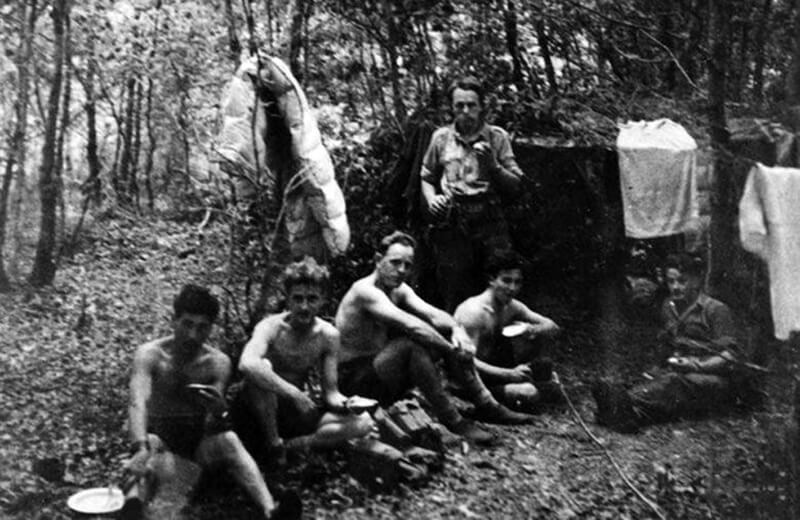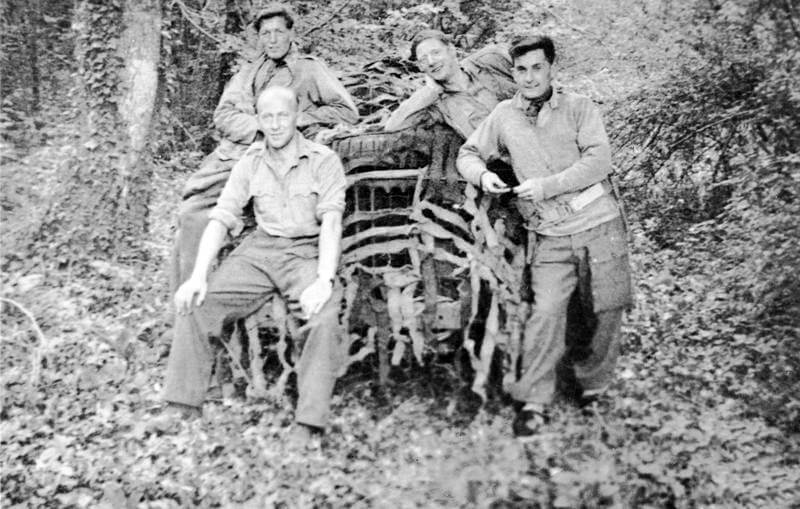| Page Created |
| June 29th, 2023 |
| Last Updated |
| Country |
| Special Forces |
| Special Air Service |
| Date |
| Operation |
| Objectives |
| Operational Area |
| Unit Force |
- 4th Special Air Service
| Opposing Forces |
| Operation |
Operation Bulbasket was a strategic initiative conducted by ‘B’ Squadron of the 1st Special Air Service (SAS) during World War II. Carried out between June and August 1944, the operation took place behind enemy lines in German-occupied France. Positioned to the east of Poitiers, in the Vienne department of southwestern France, the mission’s primary goal was to disrupt the Paris to Bordeaux railway line near Poitiers. This was part of an effort to obstruct German reinforcements, particularly targeting the 2nd SS Panzer Division Das Reich, from efficiently reaching the Normandy beachheads where Allied forces had landed.
In May 1944, the Supreme Headquarters Allied Expeditionary Force (SHAEF) had issued an order for the Special Air Service Brigade to carry out two operations in France, Houndsworth in the area of Dijon for ‘A’ Squadron and Bulbasket, near Poitiers, which was given to ‘B’ Squadron.
Both Operation Hounsworth and Operation Bulbasket were strategically designed to impede the movement of German reinforcements from southern France to the Normandy invasion fronts. The Special Air Service was tasked with a series of disruptive actions including the destruction of supply depots, obstruction of the Paris to Bordeaux railway line near Poitiers, and assaults on railway sidings and fuel trains. A key goal was to delay the 2nd SS Panzer Division – Das Reich, stationed near Toulouse, which intelligence from the Supreme Headquarters Allied Expeditionary Force (SHAEF) indicated would take approximately three days to reach the battlefront in Normandy.
The leadership of ‘B’ Squadron for Operation Bulbasket was assigned to Captain John Tonkin of the 1st SAS, with Second Lieutenant Richard Crisp as his deputy. Both officers received their operational briefing from SHAEF in London on June 1, 1944. In the following days, they liaised with the Special Operations Executive, which had agents from ‘F’ section active in the region under the leadership of Captain Maingard, known by the alias ‘Samuel’. These agents had established connections with the primary French Resistance factions in the vicinity—the Francs tireurs et Partisans and the Armée Secrète. Additionally, Tonkin was provided with a catalogue of railway targets by the Special Air Service headquarters, ensuring that the squadron was well-prepared with precise objectives for their critical mission.
During Operation Bulbasket, the SAS operatives achieved several objectives, one of which was the crucial identification of a fuel supply train destined for the 2nd SS Panzer Division. The intelligence they gathered led to the destruction of the train by Royal Air Force bombers on the same night.
However, the operation faced a dire turn of events when the SAS’s base near Verrières was compromised. The location had been revealed to the Germans, resulting in a devastating attack on the camp. In the aftermath, 33 members of the Special Air Service were captured. Tragically, these men, along with a USAAF pilot who had joined them after ejecting from his P-51 aircraft, were later executed.
Additionally, seven Maquisards—members of the French Resistance—who had been captured were executed in the woods subsequent to the attack. In a further grim act, three wounded SAS soldiers who had been hospitalised were killed with lethal injections while still in their hospital beds.
The vanguard of Operation Bulbasket, including Captain John Tonkin, was transported to France in a Handley Page Halifax from ‘B’ Flight, No. 161 Squadron RAF—a squadron designated for special duties. They arrived at their drop zone, located in the Brenne marshes 19 miles southwest of Châteauroux, at 01:37 hours on June 6, 1944, D-Day. There to receive them was their SOE liaison, Captain Maingard. ‘B’ Squadron’s additional forces parachuted into the area on June 7 and June 11, accompanied by Jeeps armed with Vickers K machine guns.
Once deployed, the SAS Squadron initiated operations to disrupt German reinforcements heading to Normandy. They sabotaged railway lines, laid mines, patrolled in their Jeeps, and trained French Resistance fighters. On June 10, a French railway worker tipped off Tonkin about a train with at least eleven petrol tankers at the Châtellerault sidings, designated for the 2nd SS Panzer Division. To verify this, Tonkin sent Lieutenant Tomos Stephens on a solo reconnaissance mission. Stephens cycled the 74-mile round trip, confirming the train’s location and its heavy guard on June 11. Tonkin then requested an RAF air strike, which was carried out that night by 12 Mosquito bombers from RAF Lasham’s No. 138 Wing and Gravesend’s 140 Wing, successfully striking the train.
To evade detection by German radio direction-finding equipment or informers, Tonkin frequently relocated their base, choosing sites near water sources and drop zones for resupply. The camp near Verrières, situated close to the drop zone at La Font d’Usson with ample water, was occupied from June 25 to July 1. However, with the local populace becoming aware of their presence, raising the risk of informers, Tonkin moved the squadron to Bois des Cartes. When the water supply there failed, they temporarily returned to Verrières while searching for a better location.
The German assault commenced at the break of dawn and concluded by 14:00. In the ensuing chaos as the Germans scoured the forest, the SAS operatives attempted to escape. A group of 34, navigating a forest trail, walked into an ambush and were taken prisoner. Their leader, Lieutenant Tomos Stephens, was brutally killed by a German officer with the butt of a rifle; in addition, seven Maquisards who had been captured were executed in the forest. Both the SAS soldiers and the American pilot, Second Lieutenant Lincoln Bundy, should have received treatment as prisoners of war, but Hitler’s Commando Order, which mandated the execution of captured commandos, sealed their fate. A dispute erupted between the German Army and the SS over the execution, with the Army ultimately being tasked with the grim deed. On July 7, the remaining POWs, comprising 30 SAS members and Second Lieutenant Bundy, were led into the woods near St Sauvant. There, they were forced to dig their graves before being shot at dawn by a German firing squad under SS Major Josef Kieffer. Their remains were buried in a communal grave. Meanwhile, three injured SAS members in hospital were killed via lethal injections. The executed men from the woods were later exhumed and reburied in the Rom village cemetery in Deux-Sèvres. The hospital victims’ bodies were never recovered, yet a commemorative plaque in Rom honors them alongside the graves of their fellow soldiers.
In retaliation, a Jedburgh team from the UK Special Forces, codenamed Hugh and active in the region, reported back to HQ calling for a counterstrike on the 17th SS Panzergrenadier Division’s base in Bonneuil-Matours. After receiving the request, Special Forces HQ relayed it to SAS Brigade HQ, who then engaged No. 2 Group RAF from the Second Tactical Air Force. The operation was entrusted to No. 140 Wing RAF by Air Vice-Marshal Basil Embry, the Air Officer Commanding of 2 Group. This wing had previously executed an airstrike on supply trains in Châtellerault at Bulbasket’s behest. Now stationed at RAF Thorney Island, on July 14, 1944, Embry personally briefed 14 crews for the mission. The attack was structured in four stages: four Mosquitos would drop high-explosive bombs, followed by six aircraft deploying US M76 incendiary bombs. Subsequent aircraft would unleash additional high-explosive ordnance, and a final strafing run would be conducted before the squadron returned to base.
Captain Tonkin, along with eight survivors of the German onslaught and three others who were on a separate mission at the time, managed to evade capture. They continued their guerrilla activities until they received orders to stand down on July 24, 1944. During the six-week period of their operations, the SAS Squadron struck railway lines 15 times, laid mines on significant routes like the Route nationale 10 south of Vivonne, and the Route nationale N147 between Angers, Poitiers, and Limoges. They also engaged in opportunistic attacks against the enemy. Notably, on the night of June 12-13, 1944, Lieutenant Crisp led a mine-laying mission on the N147 in the Forêt de Défant, strategically timed before the arrival of the 2nd SS Panzer Division in the vicinity.
The 2nd SS Panzer Division was infamously involved in the atrocities of the Tulle murders on June 9, 1944, and the massacre at Oradour-sur-Glane on June 10. The Bulbasket operations, among others, effectively delayed the division’s movement to Normandy until the end of June. This division was also implicated in the capture of SOE agent Violette Szabo on June 10, who was subsequently turned over to the Sicherheitsdienst in Limoges.
In the aftermath of the German retreat in December 1944, a group of forestry workers near St Sauvant stumbled upon signs of a mass grave. The police began excavation on December 18 and uncovered the remains of numerous individuals, many still clad in Allied uniforms. While most identification tags were missing, two tags and a name inscribed in a tunic helped identify the fallen as members of Operation Bulbasket, including Second Lieutenant Bundy, whose body was dressed in civilian attire.
The recovered bodies were honorably reinterred in the Rom village cemetery. Although the remains of the three hospital-executed SAS men were never found, a memorial plaque at Rom cemetery commemorates their sacrifice beside their SAS brethren. Lieutenant Stephens, who was killed by physical assault, rests in the cemetery at Verrières.
Operation Bulbasket’s outcomes includes initiating up to five air raids, resulting in over 150 German casualties; the destruction of vital fuel reserves, impeding the 2nd Panzer Division’s deployment to Normandy; contributing to the delay of the 226th and 227th Infantry Divisions’ advance from Bayonne and Carcassonne, respectively; and successfully executing 23 sabotage operations against road and rail targets.
| Multimedia |


